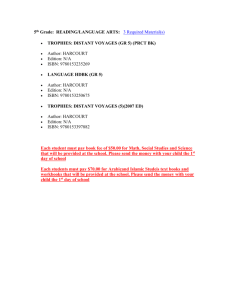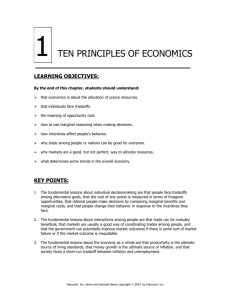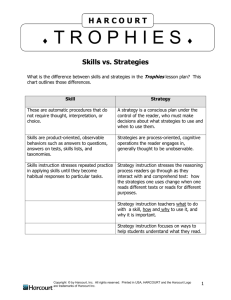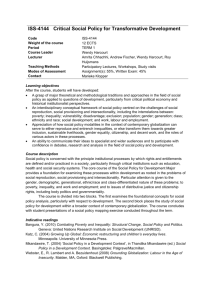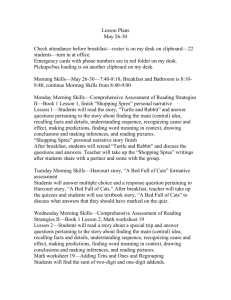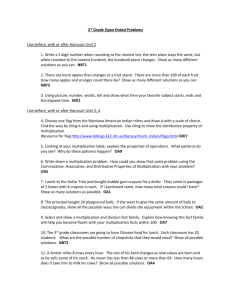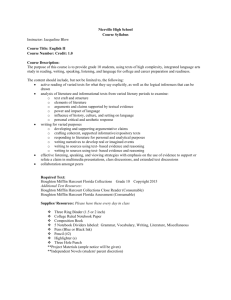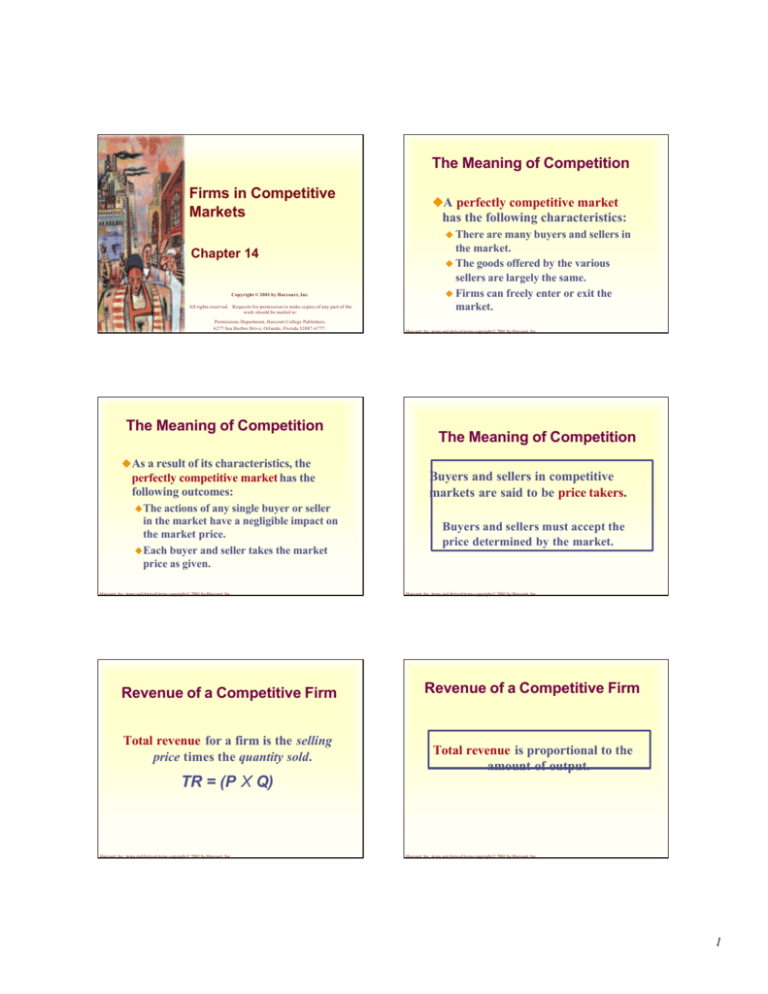
The Meaning of Competition
Firms in Competitive
Markets
uA perfectly competitive market
has the following characteristics:
u There are many buyers and sellers in
Chapter 14
Copyright © 2001 by Harcourt, Inc.
All rights reserved. Requests for permission to make copies of any part of the
work should be mailed to:
Permissions Department, Harcourt College Publishers,
6277 Sea Harbor Drive, Orlando, Florida 32887-6777.
The Meaning of Competition
the market.
goods offered by the various
sellers are largely the same.
u Firms can freely enter or exit the
market.
u The
Harcourt, Inc. items and derived items copyright © 2001 by Harcourt, Inc.
The Meaning of Competition
uAs a result of its characteristics, the
perfectly competitive market has the
following outcomes:
actions of any single buyer or seller
in the market have a negligible impact on
the market price.
uEach buyer and seller takes the market
price as given.
Buyers and sellers in competitive
markets are said to be price takers.
uThe
Harcourt, Inc. items and derived items copyright © 2001 by Harcourt, Inc.
Revenue of a Competitive Firm
Total revenue for a firm is the selling
price times the quantity sold.
Buyers and sellers must accept the
price determined by the market.
Harcourt, Inc. items and derived items copyright © 2001 by Harcourt, Inc.
Revenue of a Competitive Firm
Total revenue is proportional to the
amount of output.
TR = (P X Q)
Harcourt, Inc. items and derived items copyright © 2001 by Harcourt, Inc.
Harcourt, Inc. items and derived items copyright © 2001 by Harcourt, Inc.
1
Revenue of a Competitive Firm
Revenue of a Competitive Firm
In perfect competition, average
revenue equals the price of the
good.
Average revenue tells us how much
revenue a firm receives for the
typical unit sold.
Average revenue =
=
Total revenue
Quantity
(Price × Quantity)
Quantity
= Price
Harcourt, Inc. items and derived items copyright © 2001 by Harcourt, Inc.
Revenue of a Competitive Firm
Harcourt, Inc. items and derived items copyright © 2001 by Harcourt, Inc.
Revenue of a Competitive Firm
Marginal revenue is the change in
total revenue from an additional unit
sold.
For competitive firms, marginal
revenue equals the price of the
good.
MR =∆TR/ ∆Q
Harcourt, Inc. items and derived items copyright © 2001 by Harcourt, Inc.
Revenue of a Competitive Firm
n
n
n
n
n
MR = ∆TR/ ∆Q
TR = P * Q
P is fixed for competitive firms (firms
are price takers).
Therefore, when Q rises by 1 unit, TR
rises by P dollars.
Thus, MR = P for competitive firms.
Harcourt, Inc. items and derived items copyright © 2001 by Harcourt, Inc.
Harcourt, Inc. items and derived items copyright © 2001 by Harcourt, Inc.
Total, Average, and Marginal
Revenue for a Competitive Firm
Quantity
(Q)
1
2
3
4
5
6
7
8
Price
(P)
$6.00
$6.00
$6.00
$6.00
$6.00
$6.00
$6.00
$6.00
Total Revenue Average Revenue Marginal Revenue
(TR=PxQ)
(AR=TR/Q)
(MR=∆TR/ ∆Q )
$6.00
$6.00
$12.00
$6.00
$6.00
$18.00
$6.00
$6.00
$24.00
$6.00
$6.00
$30.00
$6.00
$6.00
$36.00
$6.00
$6.00
$42.00
$6.00
$6.00
$48.00
$6.00
$6.00
Harcourt, Inc. items and derived items copyright © 2001 by Harcourt, Inc.
2
Profit Maximization:
A Numerical Example
Profit Maximization for the
Competitive Firm
uThe
goal of a competitive firm is to
maximize profit.
uThis means that the firm will want
to produce the quantity that
maximizes the difference between
total revenue and total cost.
Harcourt, Inc. items and derived items copyright © 2001 by Harcourt, Inc.
Price
(P)
$6.00
$6.00
$6.00
$6.00
$6.00
$6.00
$6.00
$6.00
Quantity
(Q)
0
1
2
3
4
5
6
7
8
Total Revenue
(TR=PxQ)
$0.00
$6.00
$12.00
$18.00
$24.00
$30.00
$36.00
$42.00
$48.00
Total Cost
(TC)
$3.00
$5.00
$8.00
$12.00
$17.00
$23.00
$30.00
$38.00
$47.00
Profit
(TR-TC)
-$3.00
$1.00
$4.00
$6.00
$7.00
$7.00
$6.00
$4.00
$1.00
Marginal Revenue Marginal Cost
(MR=∆TR/ ∆Q ) MC= ∆ T C / ∆ Q
$6.00
$6.00
$6.00
$6.00
$6.00
$6.00
$6.00
$6.00
$2.00
$3.00
$4.00
$5.00
$6.00
$7.00
$8.00
$9.00
Harcourt, Inc. items and derived items copyright © 2001 by Harcourt, Inc.
Harcourt, Inc. items and derived items copyright © 2001 by Harcourt, Inc.
Profit Maximization for the
Competitive Firm...
Costs
and
Revenue
MC2
The firm maximizes
profit by producing
the quantity at
which marginal cost
equals marginal
revenue.
Profit Maximization for the
Competitive Firm
MC
ATC
P=MR1
P = AR = MR
AVC
Profit maximization occurs at the
quantity where marginal revenue
equals marginal cost.
MC1
0
Q1
QMAX
Q2
Quantity
Harcourt, Inc. items and derived items copyright © 2001 by Harcourt, Inc.
Copyright © 2001 by Harcourt, Inc. All rights reserved
Profit Maximization for the
Competitive Firm
The Marginal-Cost Curve and the
Firm’s Supply Decision...
Costs
and
Revenue
When MR > MC ê increase Q
When MR < MC ê decrease Q
This section of the
firm’s MC curve is
also the firm’s
supply curve.
MC
P2
ATC
P1
AVC
When MR = MC ê Profit is
maximized.
Harcourt, Inc. items and derived items copyright © 2001 by Harcourt, Inc.
0
Q1
Q2
Quantity
3
The Firm’s Short-Run Decision
to Shut Down
uA
shutdown refers to a short-run
decision not to produce anything
during a specific period of time
because of current market
conditions.
uExit refers to a long-run decision to
leave the market.
Harcourt, Inc. items and derived items copyright © 2001 by Harcourt, Inc.
The Firm’s Short-Run Decision
to Shut Down
The Firm’s Short-Run Decision
to Shut Down
The firm considers its sunk costs
when deciding to exit, but ignores
them when deciding whether to shut
down.
uSunk costs
are costs that have
already been committed and cannot
be recovered.
Harcourt, Inc. items and derived items copyright © 2001 by Harcourt, Inc.
The Firm’s Short-Run Decision to
Shut Down...
Costs
u The firm shuts down if the revenue it
MC
gets from producing is less than the
variable cost of production.
Shut down if TR < VC
Shut down if TR/Q < VC/Q
Shut down if P < AVC
Firm’s short- run
supply curve.
If P > ATC,
keep producing
at a profit.
ATC
If P > AVC,
keep producing
in the short run.
If P < AVC,
shut down.
0
Harcourt, Inc. items and derived items copyright © 2001 by Harcourt, Inc.
How to Maximize Profit in
the Short Run
n
1.
2.
There is a 2 step process a firm must
follow in order to maximize profit.
Find the point where price equals
marginal cost.
If price is greater than average variable
cost, produce Q units. If not, shut down
in the short run.
Harcourt, Inc. items and derived items copyright © 2001 by Harcourt, Inc.
AVC
Quantity
Harcourt, Inc. items and derived items copyright © 2001 by Harcourt, Inc.
The Firm’s Short-Run Decision
to Shut Down
The portion of the marginal-cost
curve that lies above average
variable cost is the competitive
firm’s short-run supply curve.
Harcourt, Inc. items and derived items copyright © 2001 by Harcourt, Inc.
4
The Firm’s Long-Run Decision to
Exit or Enter a Market
u In
the long-run, the firm exits if the
revenue it would get from producing is
less than its total cost.
The Firm’s Long-Run Decision to
Exit or Enter a Market
u A firm will enter the industry if such an
action would be profitable.
Enter if TR > TC
Exit if TR < TC
Exit if TR/Q < TC/Q
Exit if P < ATC
Harcourt, Inc. items and derived items copyright © 2001 by Harcourt, Inc.
How to Maximize Profit in
the Long Run
There is a 2 step process a firm must
follow in order to maximize profit.
1. Find the point where price equals
marginal cost.
2. If price is greater than average variable
cost, produce Q units. If not, exit the
industry in the long run.
n
Enter if TR/Q > TC/Q
Enter if P > ATC
Harcourt, Inc. items and derived items copyright © 2001 by Harcourt, Inc.
The Competitive Firm’s LongRun Supply Curve...
Costs
MC = Long-run S
Firm enters
if P > ATC
ATC
AVC
Firm exits
if P < ATC
0
Harcourt, Inc. items and derived items copyright © 2001 by Harcourt, Inc.
The Competitive Firm’s LongRun Supply Curve
Quantity
Harcourt, Inc. items and derived items copyright © 2001 by Harcourt, Inc.
The Competitive Firm’s LongRun Supply Curve...
Costs
Firm’s long-run
supply curve
The competitive firm’s long-run
supply curve is the portion of its
marginal-cost curve that lies
above average total cost.
ATC
AVC
0
Harcourt, Inc. items and derived items copyright © 2001 by Harcourt, Inc.
MC
Quantity
Harcourt, Inc. items and derived items copyright © 2001 by Harcourt, Inc.
5
The Firm’s Short-Run and
Long-Run Supply Curves
Measuring Profit in the Graph for
the Competitive Firm...
a. A Firm with Profits
Price
uShort-Run
Supply Curve
portion of its marginal cost curve
that lies above average variable cost.
uLong-Run
MC
Profit
uThe
P
ATC
P = AR = MR
ATC
Supply Curve
uThe
marginal cost curve above the
minimum point of its average total cost
curve.
Q
0
Quantity
Profit-maximizing quantity
Harcourt, Inc. items and derived items copyright © 2001 by Harcourt, Inc.
Harcourt, Inc. items and derived items copyright © 2001 by Harcourt, Inc.
Measuring Profit in the Graph for
the Competitive Firm...
Supply in a Competitive Market
b. A Firm with Losses
Price
MC
ATC
Market supply equals the sum
of the quantities supplied by the
individual firms in the market.
ATC
P
P = AR = MR
Loss
0
Q
Quantity
Loss-minimizing quantity
Harcourt, Inc. items and derived items copyright © 2001 by Harcourt, Inc.
The Short Run: Market Supply
with a Fixed Number of Firms
Harcourt, Inc. items and derived items copyright © 2001 by Harcourt, Inc.
The Short Run: Market Supply
with a Fixed Number of Firms...
(a) Individual Firm Supply
uFor
any given price, each firm
supplies a quantity of output so that
its marginal cost equals price.
uThe market supply curve reflects the
individual firms’ marginal cost
curves.
Price
Price
Supply
MC
$2.00
$2.00
1.00
0
Harcourt, Inc. items and derived items copyright © 2001 by Harcourt, Inc.
(b) Market Supply
1.00
100
200
Quantity
(firm)
0
100,000 200,000 Quantity
(market)
Harcourt, Inc. items and derived items copyright © 2001 by Harcourt, Inc.
6
The Long Run: Market Supply
with Entry and Exit
The Long Run: Market Supply
with Entry and Exit...
(a) Firm’s Zero-Profit Condition
uFirms
will enter or exit the market
until profit is driven to zero.
uIn the long run, price equals the
minimum of average total cost.
uThe long-run market supply curve is
horizontal at this price.
Price
Price
MC
ATC
P=
minimum
ATC
Supply
Quantity
(firm)
0
Harcourt, Inc. items and derived items copyright © 2001 by Harcourt, Inc.
Firms Stay in Business with
Zero Profit
u At the end of the process of entry and
u Profit
equals total revenue minus total
cost.
u Total cost includes all the opportunity
costs of the firm.
u In the zero-profit equilibrium, the firm’s
revenue compensates the owners for the
time and money they expend to keep the
business going.
exit, firms that remain must be making
zero economic profit.
u The process of entry & exit ends only
when price and average total cost are
driven to equality.
u Long-run equilibrium must have firms
operating at their efficient scale.
Harcourt, Inc. items and derived items copyright © 2001 by Harcourt, Inc.
Increase in Demand in the Short
Run...
Increase in Demand in the
Short Run
uAn
increase in demand raises
price and quantity in the short
run.
uFirms earn profits because price
now exceeds average total cost.
(a) Initial Condition
Market
Firm
Price
Price
ATC
MC
P1
P
S1
P1
A
Long-run
supply
D1
0
Harcourt, Inc. items and derived items copyright © 2001 by Harcourt, Inc.
Quantity
(market)
0
Harcourt, Inc. items and derived items copyright © 2001 by Harcourt, Inc.
The Long Run: Market Supply
with Entry and Exit
Harcourt, Inc. items and derived items copyright © 2001 by Harcourt, Inc.
(b) Market Supply
Quantity
(firm)
0
Q1
Quantity
(market)
Harcourt, Inc. items and derived items copyright © 2001 by Harcourt, Inc.
7
Increase in Demand in the Short
Run...
Increase in Demand in the Short
Run...
(b) Short-Run Response
(c) Long-Run Response
Market
Firm
Price
Profit
MC ATC
P2
P2
P1
P1
B
0
Price
S1
MC ATC
P2
A
D1
Quantity
(firm)
0
Market
Firm
Price
Price
Q1 Q2
Long-run
supply
D2
Quantity
(market)
Harcourt, Inc. items and derived items copyright © 2001 by Harcourt, Inc.
P1
P1
B
A
S1
C
D1
Quantity
(firm)
0
0
S2
Long-run
supply
D2
Q1 Q2 Q3
Quantity
(market)
Harcourt, Inc. items and derived items copyright © 2001 by Harcourt, Inc.
Why the Long-Run Supply
Curve Might Slope Upward
Marginal Firm
uSome
resources used in
production may be available only
in limited quantities.
uFirms may have different costs.
Harcourt, Inc. items and derived items copyright © 2001 by Harcourt, Inc.
The marginal firm is the firm
that would exit the market if
the price were any lower.
Harcourt, Inc. items and derived items copyright © 2001 by Harcourt, Inc.
Summary
uBecause
a competitive firm is a price
taker, its revenue is proportional to
the amount of output it produces.
uThe price of the good equals both the
firm’s average revenue and its
marginal revenue.
Harcourt, Inc. items and derived items copyright © 2001 by Harcourt, Inc.
Summary
uTo
maximize profit a firm chooses
the quantity of output such that
marginal revenue equals marginal
cost.
uThis is also the quantity at which
price equals marginal cost.
uTherefore, the firm’s marginal cost
curve is its supply curve.
Harcourt, Inc. items and derived items copyright © 2001 by Harcourt, Inc.
8
Summary
u In
the short run when a firm cannot
recover its fixed costs, the firm will choose
to shut down temporarily if the price of
the good is less than average variable cost.
u In the long run when the firm can recover
both fixed and variable costs, it will
choose to exit if the price is less than
average total cost.
Harcourt, Inc. items and derived items copyright © 2001 by Harcourt, Inc.
Summary
uIn
a market with free entry and exit,
profits are driven to zero in the long
run and all firms produce at the
efficient scale.
uChanges in demand have different
effects over different time horizons.
Harcourt, Inc. items and derived items copyright © 2001 by Harcourt, Inc.
9


